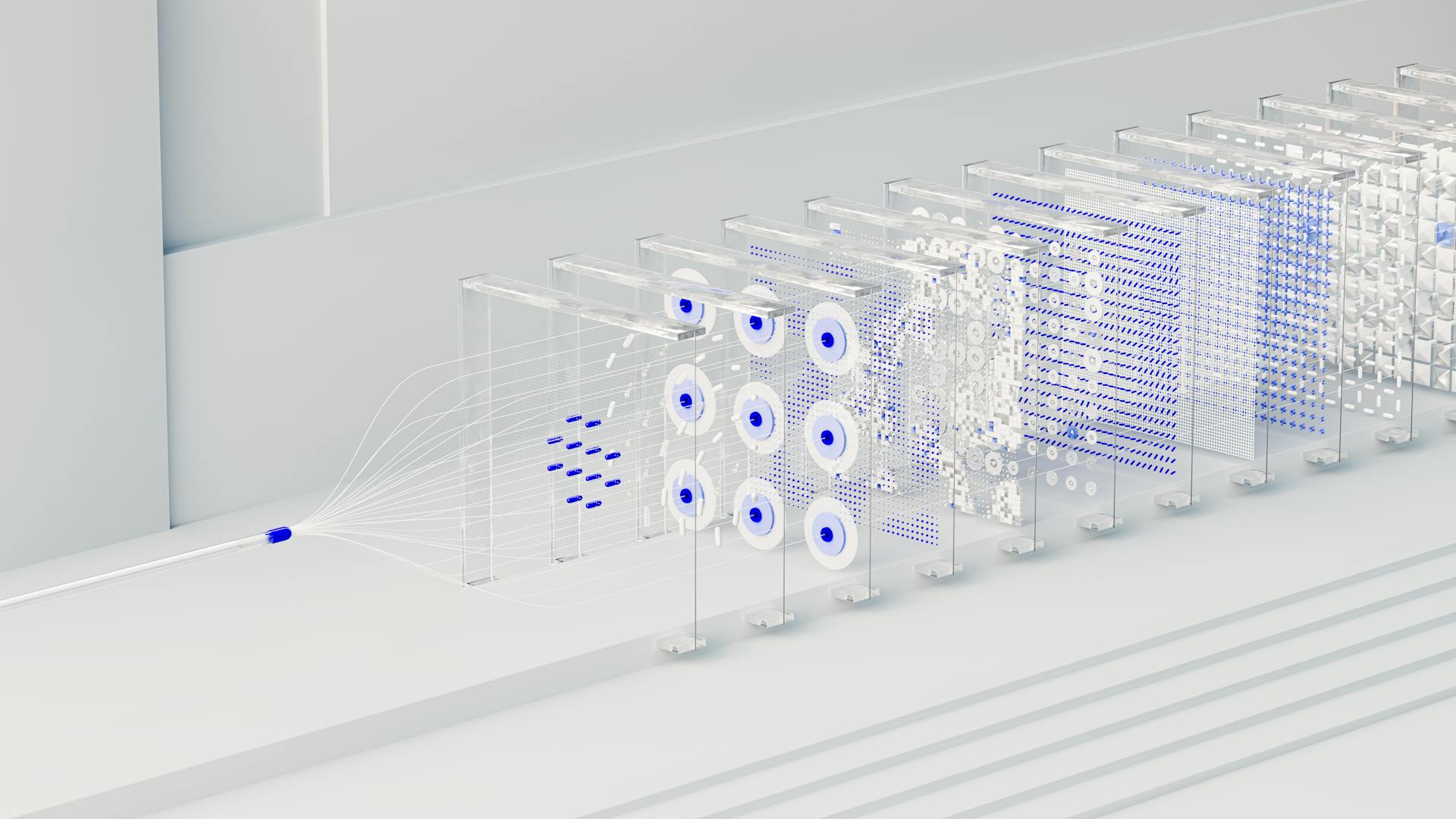
Computer vision AI is revolutionizing industries by enabling machines to interpret and understand visual data from images and videos. This technology has the potential to automate various tasks, from quality control to surveillance.
By leveraging machine learning algorithms, computer vision AI can recognize patterns and make decisions based on visual inputs. For example, self-driving cars use computer vision to detect and respond to road signs and obstacles.
The accuracy of computer vision AI has improved significantly over the years, thanks to advancements in deep learning techniques. According to recent studies, deep learning-based computer vision models have achieved state-of-the-art performance in image classification tasks.
Computer vision AI can be applied to various industries, including healthcare, finance, and manufacturing, to improve efficiency and accuracy.
Curious to learn more? Check out: Practical Machine Learning for Computer Vision
What Is Computer Vision AI?
Computer vision AI is a field that enables computers and systems to interpret and analyze visual data from digital images, videos, and other visual inputs.
It's a whole area of research on various image processing algorithms, including methods based on Deep Learning, CNN, Machine Learning, and AI.
Curious to learn more? Check out: Computational Learning Theory
Computer vision AI involves acquiring, analyzing, and processing images or video to derive information and decide based on that data.
Some of its typical real-world applications include object detection, visual content processing, understanding and analysis, product search, image classification and search, and content moderation.
By using computer vision AI, computers and machines can respond to image data from the world around them, making it a powerful tool for various industries and applications.
You might enjoy: Computer Vision vs Machine Learning
Key Components and Functionality
Computer vision AI relies on several key components to interpret and make sense of visual data. These components include image processing, feature extraction, object recognition, image classification, object detection, image segmentation, and scene understanding.
Image acquisition is the first step in this process, typically using cameras, sensors, or other digital input devices. Image processing follows, with adjustments to brightness and contrast, scaling, cropping, or converting to different formats.
The key techniques used in computer vision AI include convolutional neural networks (CNNs), image processing algorithms, feature extraction methods, object detection algorithms (such as YOLO and SSD), and semantic segmentation. These techniques form the foundation of modern computer vision systems, enabling tasks like image classification, object localization, and scene understanding.
Here are the critical components of computer vision:
- Image Acquisition: Captures visual data using cameras, sensors, or other digital input devices.
- Image Processing: Adjusts brightness and contrast, scales, crops, or converts images to different formats.
- Feature Detection and Extraction: Identifies specific patterns or characteristics in images.
- Pattern Recognition and Classification: Interprets detected features against known patterns.
- Decision Making: Makes decisions or recommendations based on image data interpretation.
Computer vision systems also rely on input devices, processing units, storage, software and algorithms, and output interfaces. These components work together to enable machines to interpret and make sense of visual data.
Key Components
Computer vision AI relies on a combination of key components to interpret and make sense of visual data. These components work together to enable machines to understand the world around them.
Image acquisition is the first step in the process, capturing visual data using cameras, sensors, or other digital input devices. This data is then processed to adjust brightness and contrast, scale, crop, or convert to different formats.
Feature detection and extraction is where the system identifies specific patterns or characteristics in the image, such as edges, textures, or particular shapes. This is often done using machine learning algorithms, particularly deep learning.
Pattern recognition and classification is where the system interprets what it sees by comparing the detected features against known patterns. This is often where machine learning algorithms come into play, enabling the system to make decisions or recommendations.

The core components of a computer vision system include input devices, processing units, storage, software and algorithms, and output interface. These components work together to enable the system to capture, process, and interpret visual data.
Here are the key components of a computer vision system:
- Input Devices: Cameras, sensors, and other digital input devices.
- Processing Units: Hardware components, like CPUs, GPUs, or TPUs, that process the data.
- Storage: For storing the vast amounts of data computer vision systems generate and use.
- Software and Algorithms: The core of a computer vision system comprises various algorithms for image processing, feature extraction, pattern recognition, and machine learning.
- Output Interface: This includes the mechanisms through which the system communicates its findings or takes actions.
Functionality
Computer vision AI is capable of analyzing visual data in real-time or from stored images/videos, identifying patterns, objects, faces, scenes, and more. This is made possible through functionality such as image and video analysis.
Image and video analysis involves breaking down complex visual data into manageable parts, allowing the system to identify objects, patterns, and scenes. For instance, a system can analyze a video stream to track and analyze the movement of objects or individuals over time.
Object detection and recognition is another key functionality of computer vision AI, enabling the identification and classification of objects within images or video streams. This is achieved through techniques such as convolutional neural networks (CNNs) and object detection algorithms like YOLO and SSD.

Some systems can even reconstruct a 3D scene from 2D images, showcasing the advanced capabilities of computer vision AI. This is particularly useful in applications such as medical imaging, where accurate 3D reconstructions can aid in diagnosis and treatment.
Here are some of the key functionalities of computer vision AI, summarized in a list:
- Image and Video Analysis
- Object Detection and Recognition
- Scene Reconstruction
- Motion Analysis
- Image Restoration
Applications and Use Cases
Computer vision AI has numerous applications across various domains. It's used in facial recognition for security systems, smartphone unlocking, and law enforcement.
In autonomous vehicles, computer vision is critical for detecting objects, reading road signs, and navigating through traffic. This technology has the potential to revolutionize the way we travel.
Computer vision is also used in medical imaging analysis, where algorithms can analyze complex medical images like X-rays, MRIs, and CT scans to assist doctors in diagnosing diseases more accurately and quickly.
Here are some key applications of computer vision AI:
- Facial Recognition
- Self-Driving Cars
- Medical Imaging Analysis
- Industrial Automation
- Agricultural & Aquaculture Automation
- Retail
- Augmented Reality
- Surveillance
- Sports Analysis
- Robotics
Common Applications
Computer vision AI has numerous applications across various industries, making it a game-changer for efficiency and decision-making.
Facial recognition is a common application of computer vision AI, used for identifying or verifying a person's identity using their face. This technology is used in security systems, smartphone unlocking, and law enforcement.
Autonomous vehicles rely heavily on computer vision AI to detect objects, read road signs, and navigate through traffic. This technology is critical for self-driving cars.
Medical imaging analysis is another significant application of computer vision AI, which can analyze complex medical images like X-rays, MRIs, and CT scans to assist doctors in diagnosing diseases more accurately and quickly.
Computer vision AI is also used in industrial automation to inspect products on assembly lines, ensuring quality control and defect identification.
Here are some of the many applications of computer vision AI:
- Facial Recognition: Security systems, smartphone unlocking, law enforcement
- Self-Driving Cars: Detecting objects, reading road signs, navigating through traffic
- Medical Imaging Analysis: Analyzing X-rays, MRIs, and CT scans to diagnose diseases
- Industrial Automation: Inspecting products on assembly lines for quality control
- Agricultural & Aquaculture Automation: Crop monitoring, disease detection, automated harvesting
- Retail: Inventory management, checkout-free shopping experiences, customer behavior analysis
- Augmented Reality: Integrating digital information with the user's environment in real-time
- Surveillance: Monitoring video footage for security purposes, detecting anomalies
- Sports Analysis: Analyzing athletes' performances, improving game strategies
- Robotics: Enabling robots to navigate, interact with objects, and perform complex tasks
Surveillance & Security
Computer vision AI plays a crucial role in surveillance and security systems, enabling real-time monitoring and tracking of objects and individuals.
Facial recognition technology, powered by computer vision, has transformed security systems, user authentication, and customer experience. It's used for identifying or verifying a person's identity using their face, with applications in security systems, smartphone unlocking, and law enforcement.
A fresh viewpoint: Artificial Intelligence Is the Theory and Development of Computer Systems
Object counting, movement tracking, and heatmapping are all possible with computer vision AI, making it an essential tool for monitoring and tracking in various settings.
Here are some specific surveillance and security applications of computer vision AI:
- Object counting
- Movement tracking
- Heatmapping
- People/animal behavior
- 24/7 fulltime surveillance
- Crowds and large volumes
- Checks & verification
Computer vision AI can also detect suspicious objects and patterns, as well as litter, making it a valuable tool for maintaining public spaces.
Safety procedure monitoring, abandoned object detection, vandalism alerting, signalling, and alert/alarm activation are all possible with computer vision AI, enhancing security and safety in various settings.
How It Works and Techniques Used
Computer vision AI works by utilizing various algorithms and deep learning models to process visual data. These models are trained on large datasets to recognize patterns, objects, and features within images and videos.
Convolutional neural networks (CNNs) are a key technique used in computer vision AI, enabling tasks like image classification, object localization, and scene understanding. They're a type of neural network designed specifically for image processing.
Broaden your view: What Is Ai Model Training
Machine learning models, particularly CNNs, are commonly utilized in computer vision systems to analyze and interpret image data. These models undergo training using extensive image datasets, which enables them to identify and understand various patterns and features.
The key components of computer vision AI include image processing, feature extraction, object recognition, image classification, object detection, image segmentation, and scene understanding. These components work together to enable machines to interpret and make sense of visual data.
Some of the key techniques used in computer vision AI include convolutional neural networks (CNNs), image processing algorithms, feature extraction methods, object detection algorithms (such as YOLO and SSD), and semantic segmentation. These techniques form the foundation of modern computer vision systems.
Here are some advanced deep learning techniques that are expected to grow in computer vision AI:
- Improved Neural Networks: These could offer greater accuracy and faster processing times, even with complex and large-scale visual data.
- Self-Supervised Learning: This approach, where algorithms learn to understand and categorize visual content without extensive labeled datasets, is expected to reduce the dependency on large annotated datasets.
Frequently Asked Questions
What is the difference between computer vision and visual AI?
Computer vision is a specific field focused on processing and analyzing visual data, while Visual AI encompasses a broader scope that includes computer vision and other AI applications that utilize visual data. Understanding the difference between these two terms is essential for navigating the complex world of AI and visual data analysis.
Is computer vision always AI?
Computer vision is not always AI, as it only involves collecting data through a camera, whereas AI requires processing and responding to that data. To determine if computer vision is AI, look for how the system processes and responds to the collected data.
Featured Images: pexels.com


